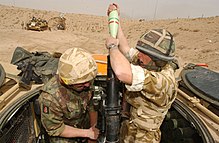Formation patch
The British Army, among others, developed a solution whereby individual divisions, brigades, battalions and even companies were identified by distinctive coloured cloth insignia, either sewn to the uniform jacket (on the sleeves, or the back of the tunic), or painted on the helmet.The United States Army, however, did develop a system of shoulder sleeve insignia with distinctive badges identifying individual divisions.By the time of the Second World War, the various armies did not feel a perceived need to identify individual battalions on battledress uniforms.[7] The 2nd Canadian Infantry Division used a "battle patch" system of geometric shapes identifying individual brigades and battalions, similar to that used by the 2nd Canadian Division in the First World War, during the 1941-42 period, but abandoned this system after the Dieppe Raid.Formation patches have survived into the 21st Century in many modern militaries, though when in use on combat uniforms are generally rendered in subdued colours and their use in their original intended purpose - battlefield identification - is questionable.



Shoulder sleeve insigniamilitarymilitary formationsheraldryCromwellcolours, standards and guidonsWorld War IBritish ArmydivisionsbrigadesbattalionscompaniesBattle of the SommeUnited States ArmyII Canadian Corps50th (Northumbrian) Infantry DivisionSecond World WarGerman ArmyBattle DressFormation BadgesCorps, Armies, and Army Groups2nd Canadian Infantry Division2nd Canadian DivisionDieppe RaidRoyal Regiment of Fusiliers2003 invasion of Iraq7th Armoured BrigadeFormation patches of the Canadian ArmyDivisional insignia of the British ArmyBrigade insignia of the British ArmyUnit Colour PatchLaw, Clive M.Service Publications